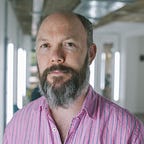Still Got It: The Lean Startup 10 Years on — Book Review
“Minimum Viable Product”
“Game-Changer”
“Disruptive”
“Pivot”
A confession: I’ve been using these words for years, without knowing their origin, or what they really mean.
There – now that’s out I feel a lot better, and it helps to know I’m not alone in my ignorance, as many memes, blogs and TV shows testify.
These buzzwords were born 10 years ago with publication of The Lean Startup by Eric Ries, and I’m glad to have dived in now, and experienced several minor epiphanies along the way.
Starting a tech agency around the same time with a friend from college, we felt intimidated by formal business plans and methodologies. They seemed geared towards established businesses with trained Managers and we couldn’t relate as ‘upstarts’.
What distinguished Ries then and now is his background as developer turned tech entrepreneur, the influence of Japanese “lean manufacturing” processes and bias towards action. This appeals to startup founders, engineers and teams with big ambitions but limited resources.
Ries defines the startup as any “human institution designed to create a new product or service under conditions of extreme uncertainty.” Right now, that applies whether you’re working alone, in an incubator or as part of a mature, multinational organisation.
As humans we seize on ‘brilliant ideas’ and our fear is not to ship, to miss an opportunity to launch the big product. In fact, data and case studies show the problem is more frequently that of achieving failure; successfully executing a plan that goes nowhere.
We can all think of examples of this in the workplace or as consumers, and the pattern is supported by ‘magical thinking’ and tales of entrepreneurial heroes who persisted through countless rejections, eventually to be vindicated by success.
Can we avoid these pitfalls and be one of the 10% of start-ups who don’t fail? The answer is yes; if we take an approach of rigorous experimentation to all our activities, and work with ‘small batches’ and short cycles.
The goal is to figure out the right thing to build, that which customers want and will pay for - as quickly as possible. The route to this is engaging with and talking to customers, asking 4 key questions:
1. Do customers recognise the problem you’re trying to solve?
2. If there was a solution, would they buy it?
3. Would they buy it from us?
4. Can we build a solution for that problem?
The common tendency for product development is to skip straight to the final question and build a solution before confirming customers have the problem.
As a founder who pivoted agency services into software products, Ries’ focus on a “Concierge” Minimum Viable Product (MVP) making sure the first few customers have an experience as good as you and your team can make it, resonated with my own experience.
The caveat here is that novelty is often disliked by customers used to a certain way of doing things – “If I had asked people what they wanted, they would have said faster horses” (Henry Ford).
The way I reconcile this is you need to fix a problem experienced in the world now – that is the ‘MVP’. The by-products of doing this are data, insights and techniques to build the prototype for the future paradigm – for which the TAM (Total Addressable Market) is that much larger and more exciting. This vision is owned and driven by the founder and their team.
One of the most powerful tools in this cycle of continuous experiment, testing and improvement is the 5 WHYS technique originally developed by Taiichi Ohno, architect of the Toyota Production system.
At the heart of every seemingly technical problem is a human issue, be it design, management or training. Asking 5 WHYS provide an opportunity to discover what that human problem might be, with a culture of tolerance to all errors the first time they occur, without allowing the same mistake to happen twice.
Like other popular methodologies (Agile, Privacy by Design) which capture the imagination of individuals within startups, established businesses and government, this approach only works if the organisation is committed to the process, gives it time and avoids temptations of the ‘blame game’.
Done right, the Lean Startup method has the necessary flexibility to accept, embrace and benefit from failure, or rather realisations the current direction of travel isn’t working, and change course via a pivot.
So, a startup’s “runway” is focused not on months of burn through salaries, marketing, production but the number of pivots, or revolutions of the engine left in the tank for the founders.
The final challenge is growth; be it viral, sticky or paid, it must be sustainable if not to become a ‘vanity metric’ and powered by output from the existing engine, so the data and multiplier effects can be analysed and tweaked ready for the next batch.
After a decade, some elements have dated in the fast-moving world of tech, but the game of applying the tests of Ries’ book to the latest startup heroes in the FT, Forbes or Wired is enjoyable as well as a rewarding one when planning your next move as founder, or investor.
Do contact me and share how you get on…
